
2nd edition HUMAN RESOURCE DEVELOPMENT LEARNING TRAINING for individuals organizations Edited by John P Wilson
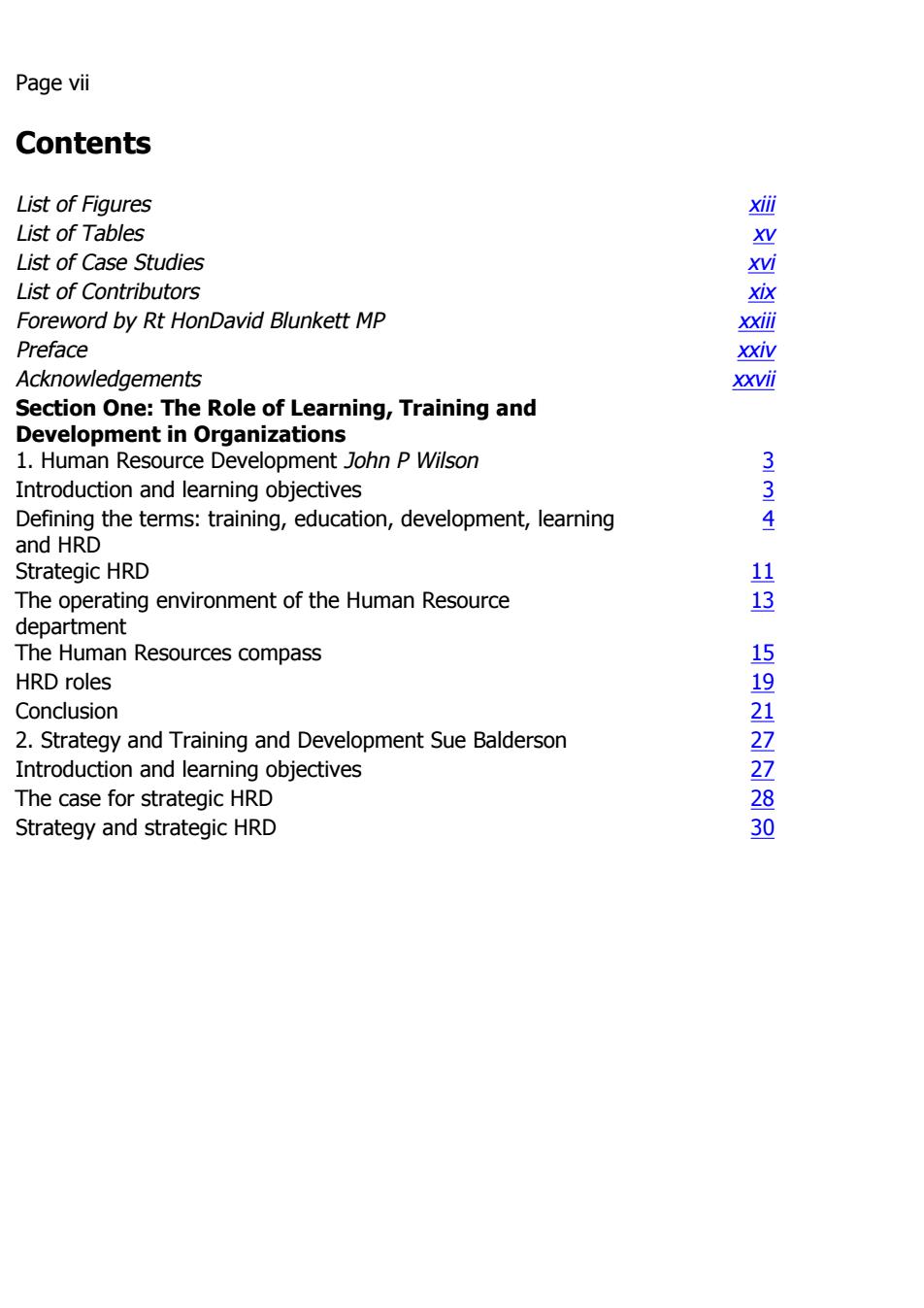
Page vii Contents List of Figure List of Tables List of Case Studies List of Contributors Foreword by Rt HonDavid Blunkett MP Preface Acknowledgements xxvii Section One:The Role of Learning,Training and Development in Organizations 1.Human Resource Development John P Wilson Introduction and learning objectives Defining the terms:training,education,development,learning 334 and HRD Strategic HRD The operating environment of the Human Resource department The Human Resources compass HRD roles Conclusion 2.Strategy and Training and Development Sue Balderson Introduction and learning objectives 591778 The case for strategic HRD Strategy and strategic HRD 0
Page vii Contents List of Figures xiii List of Tables xv List of Case Studies xvi List of Contributors xix Foreword by Rt HonDavid Blunkett MP xxiii Preface xxiv Acknowledgements xxvii Section One: The Role of Learning, Training and Development in Organizations 1. Human Resource Development John P Wilson 3 Introduction and learning objectives 3 Defining the terms: training, education, development, learning and HRD 4 Strategic HRD 11 The operating environment of the Human Resource department 13 The Human Resources compass 15 HRD roles 19 Conclusion 21 2. Strategy and Training and Development Sue Balderson 27 Introduction and learning objectives 27 The case for strategic HRD 28 Strategy and strategic HRD 30
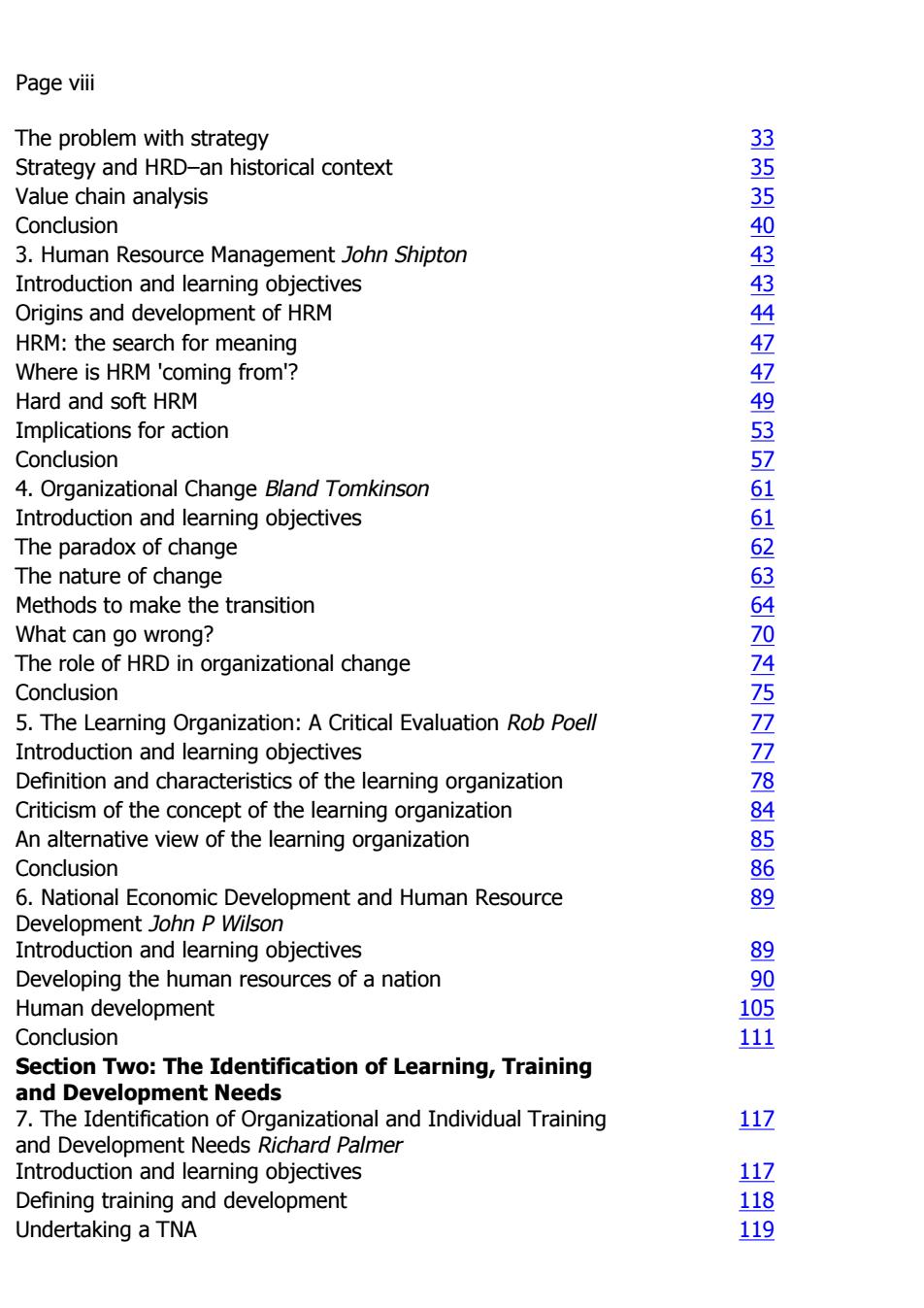
Page vii The problem with strategy Strategy and HRD-an historical context Value chain analysis Conclusion 3.Human Resource Management John Shipton Introduction and learning objectives Origins and development of HRM HRM:the search for meaning Where is HRM 'coming from'? Hard and soft HRM Implications for action Conclusion 4.Organizational Change Bland Tomkinson Introduction and learning objectives The paradox of change The nature of change Methods to make the transition What can go wrong? The role of HRD in organizational change Conclusion 3550994779371623404577849 5.The Learning Organization:A Critical Evaluation Rob Poell Introduction and learning objectives Definition and characteristics of the learning organization Criticism of the concept of the learning organization An alternative view of the learning organization Conclusion 6.National Economic Development and Human Resource 59 Development John P Wilson Introduction and learning objectives Developing the human resources of a nation Human development 器 Conclusion 1 Section Two:The Identification of Learning,Training and Development Needs 7.The Identification of Organizational and Individual Training 117 2tcocscRandieetoseegnd 11☑ Defining training and development Undertaking a TNA
Page viii The problem with strategy 33 Strategy and HRD–an historical context 35 Value chain analysis 35 Conclusion 40 3. Human Resource Management John Shipton 43 Introduction and learning objectives 43 Origins and development of HRM 44 HRM: the search for meaning 47 Where is HRM 'coming from'? 47 Hard and soft HRM 49 Implications for action 53 Conclusion 57 4. Organizational Change Bland Tomkinson 61 Introduction and learning objectives 61 The paradox of change 62 The nature of change 63 Methods to make the transition 64 What can go wrong? 70 The role of HRD in organizational change 74 Conclusion 75 5. The Learning Organization: A Critical Evaluation Rob Poell 77 Introduction and learning objectives 77 Definition and characteristics of the learning organization 78 Criticism of the concept of the learning organization 84 An alternative view of the learning organization 85 Conclusion 86 6. National Economic Development and Human Resource Development John P Wilson 89 Introduction and learning objectives 89 Developing the human resources of a nation 90 Human development 105 Conclusion 111 Section Two: The Identification of Learning, Training and Development Needs 7. The Identification of Organizational and Individual Training and Development Needs Richard Palmer 117 Introduction and learning objectives 117 Defining training and development 118 Undertaking a TNA 119
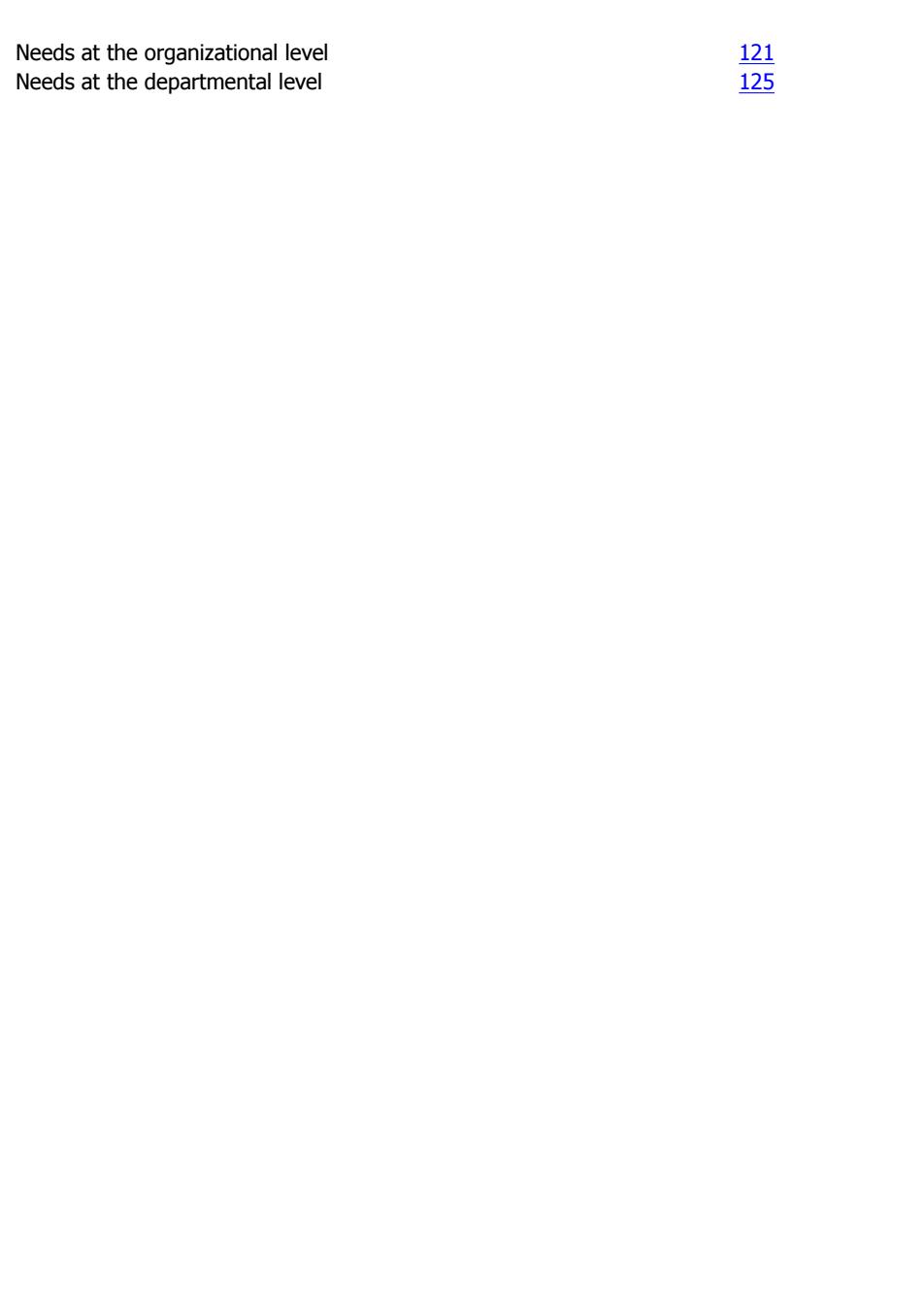
Needs at the organizational level Needs at the departmental level 选
Needs at the organizational level 121 Needs at the departmental level 125
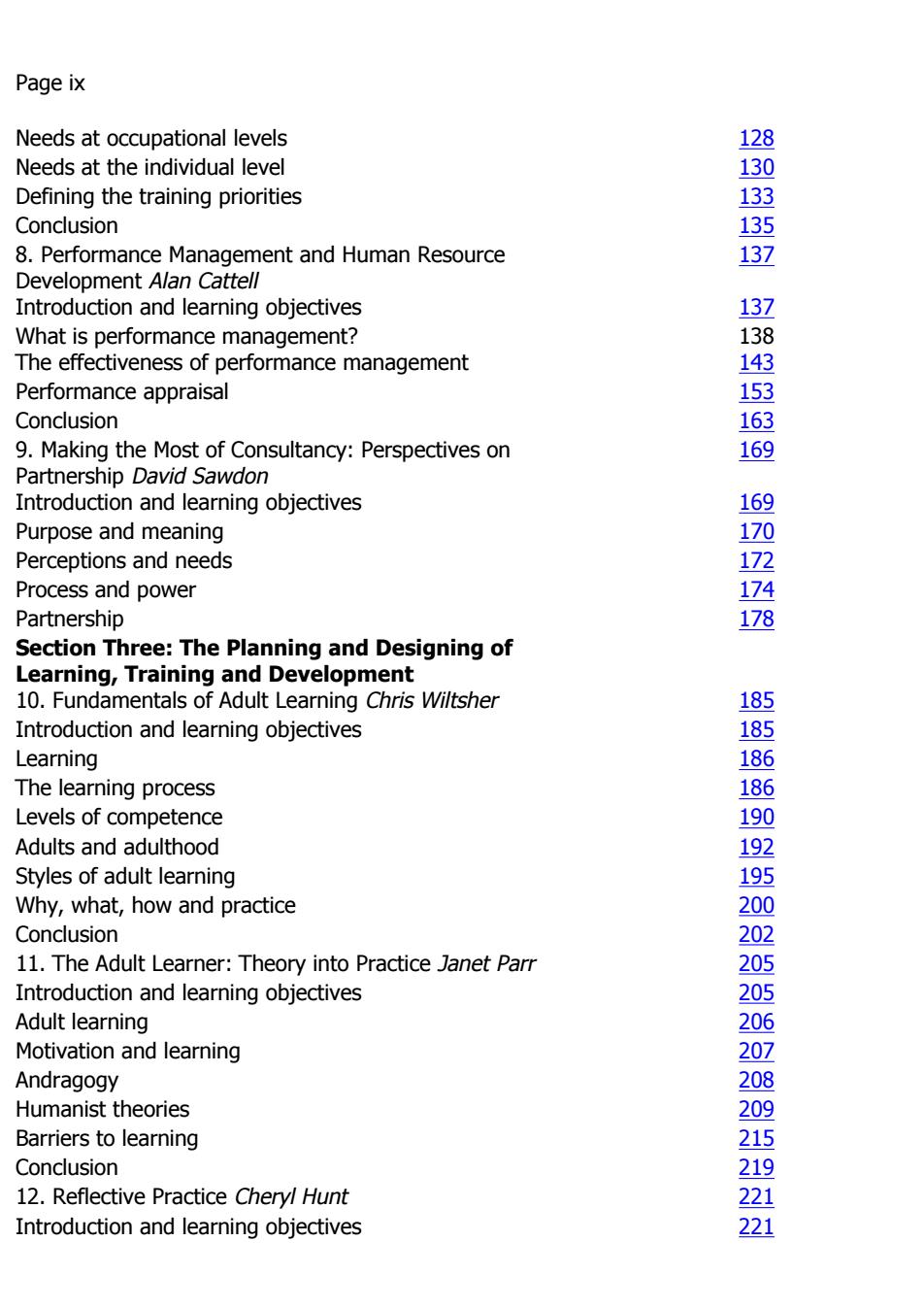
Page ix Needs at occupational levels Needs at the individual level Defining the training priorities Conclusion 8.Performance Management and Human Resource Development Alan Cattell Introduction and learning objectives What is performance management? The effectiveness of performance management Performance appraisal %035坏切645G9 Conclusion 9.Making the Most of Consultancy:Perspectives on Partnership David Sawdon Introduction and learning objectives Purpose and meaning Perceptions and needs Process and power 90功42 Partnership 10.Fundamentals of Adult Learning Chris Wiltsher Introduction and learning objectives Learning The learning process Levels of competence Adults and adulthood Styles of adult learning Why,what,how and practice Conclusion 11.The Adult Learner:Theory into Practice Janet Parr Introduction and learning objectives Adult learning Motivation and learning Andragogy Humanist theories 朗朗够够0990Q妨妨00碗0192次 Barriers to learning Conclusion 12.Reflective Practice Chery/Hunt Introduction and learning objectives
Page ix Needs at occupational levels 128 Needs at the individual level 130 Defining the training priorities 133 Conclusion 135 8. Performance Management and Human Resource Development Alan Cattell 137 Introduction and learning objectives 137 What is performance management? 138 The effectiveness of performance management 143 Performance appraisal 153 Conclusion 163 9. Making the Most of Consultancy: Perspectives on Partnership David Sawdon 169 Introduction and learning objectives 169 Purpose and meaning 170 Perceptions and needs 172 Process and power 174 Partnership 178 Section Three: The Planning and Designing of Learning, Training and Development 10. Fundamentals of Adult Learning Chris Wiltsher 185 Introduction and learning objectives 185 Learning 186 The learning process 186 Levels of competence 190 Adults and adulthood 192 Styles of adult learning 195 Why, what, how and practice 200 Conclusion 202 11. The Adult Learner: Theory into Practice Janet Parr 205 Introduction and learning objectives 205 Adult learning 206 Motivation and learning 207 Andragogy 208 Humanist theories 209 Barriers to learning 215 Conclusion 219 12. Reflective Practice Cheryl Hunt 221 Introduction and learning objectives 221

The reflective practitioner:Donald SchOn 223
The reflective practitioner: Donald SchÖn 223
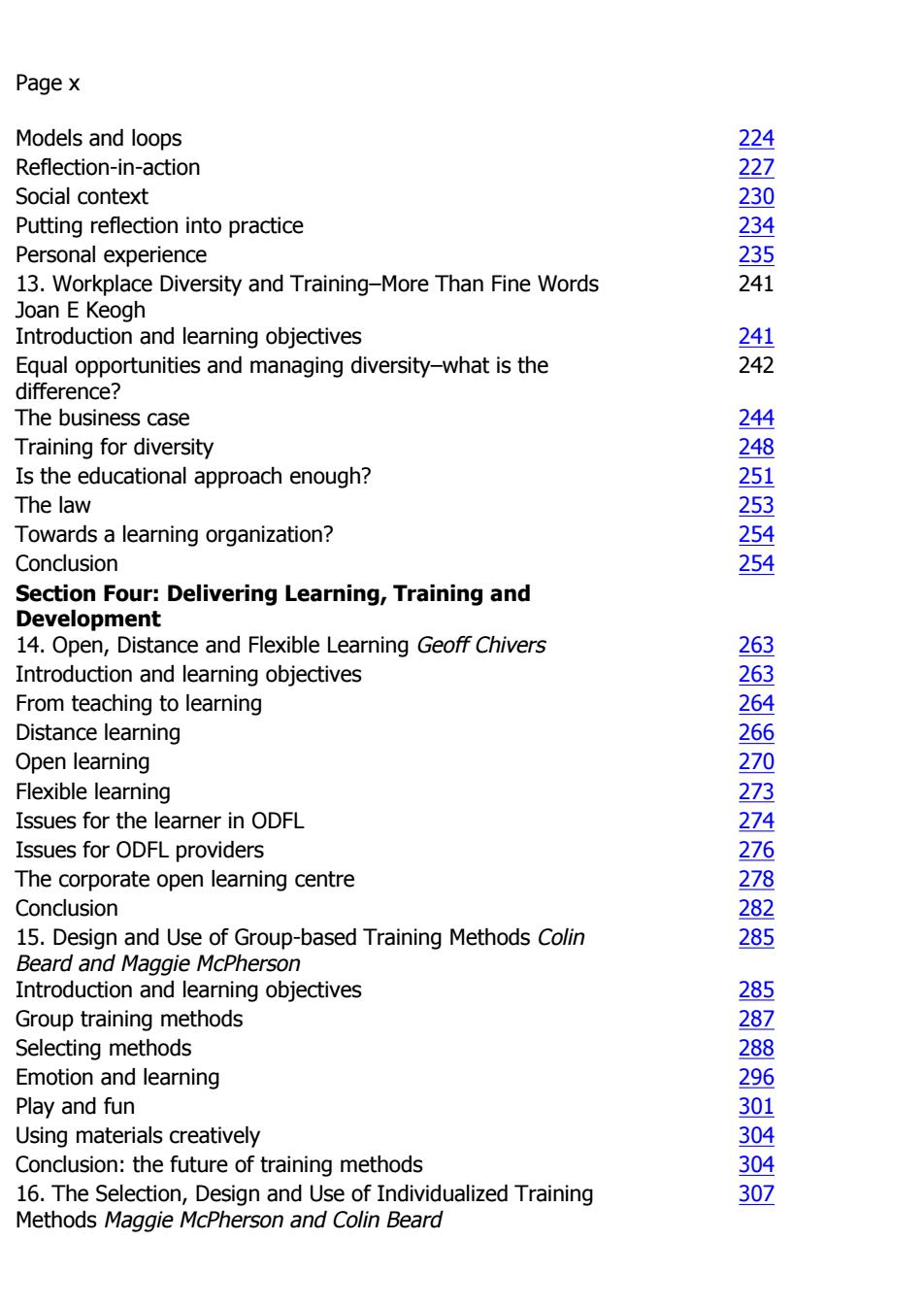
Page x Models and loops Reflection-in-action Social context Putting reflection into practice Personal experience 13.Workplace Diversity and Training-More Than Fine Words Joan E Keogh Introduction and learning objectives Equal opportunities and managing diversity-what is the 20 difference? The business case 244 Training for diversity Is the educational approach enough? The law Towards a learning organization? Conclusion Section Four:Delivering Learning,Training and Development 14.Open,Distance and Flexible Learning Geoff Chivers Introduction and learning objectives From teaching to learning Distance learning Open learning Flexible learning Issues for the learner in ODFL Issues for ODFL providers The corporate open learning centre Conclusion 15.Design and Use of Group-based Training Methods Colin 285 Beard and Maggie McPherson Introduction and learning objectives Group training methods Selecting methods Emotion and learning Play and fun Using materials creatively Conclusion:the future of training methods 60s6eoew2sa2oaman&oaoaizadTang 302
Page x Models and loops 224 Reflection-in-action 227 Social context 230 Putting reflection into practice 234 Personal experience 235 13. Workplace Diversity and Training–More Than Fine Words Joan E Keogh 241 Introduction and learning objectives 241 Equal opportunities and managing diversity–what is the difference? 242 The business case 244 Training for diversity 248 Is the educational approach enough? 251 The law 253 Towards a learning organization? 254 Conclusion 254 Section Four: Delivering Learning, Training and Development 14. Open, Distance and Flexible Learning Geoff Chivers 263 Introduction and learning objectives 263 From teaching to learning 264 Distance learning 266 Open learning 270 Flexible learning 273 Issues for the learner in ODFL 274 Issues for ODFL providers 276 The corporate open learning centre 278 Conclusion 282 15. Design and Use of Group-based Training Methods Colin Beard and Maggie McPherson 285 Introduction and learning objectives 285 Group training methods 287 Selecting methods 288 Emotion and learning 296 Play and fun 301 Using materials creatively 304 Conclusion: the future of training methods 304 16. The Selection, Design and Use of Individualized Training Methods Maggie McPherson and Colin Beard 307
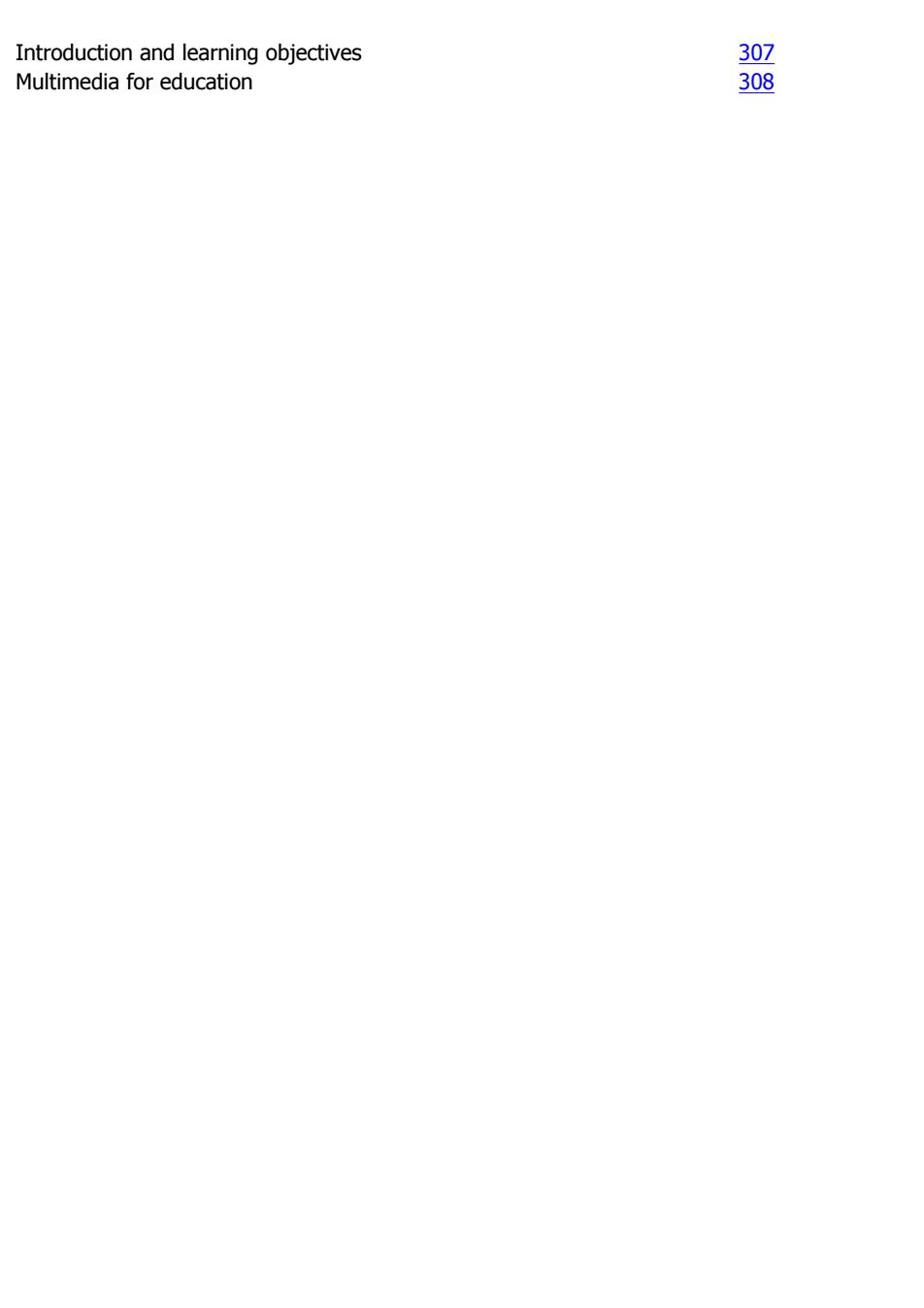
Introduction and learning objectives 307 Multimedia for education 308
Introduction and learning objectives 307 Multimedia for education 308
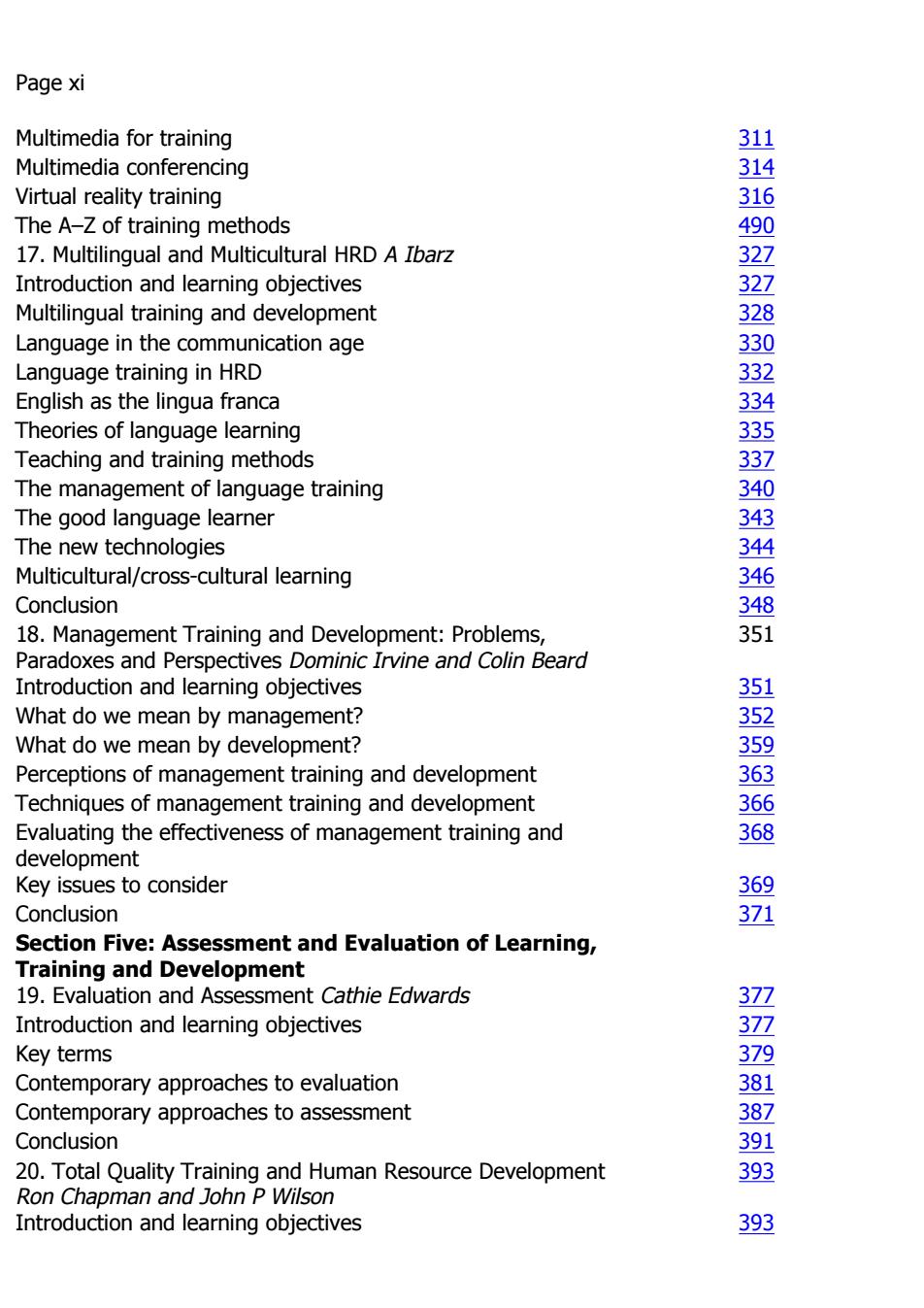
Page xi Multimedia for training Multimedia conferencing Virtual reality training The A-Z of training methods 17.Multilingual and Multicultural HRD A Ibarz Introduction and learning objectives Multilingual training and development Language in the communication age Language training in HRD English as the lingua franca Theories of language learning Teaching and training methods The management of language training The good language learner The new technologies Multicultural/cross-cultural learning 146077803953094%05 Conclusion 18.Management Training and Development:Problems, Paradoxes and Perspectives Dominic Irvine and Colin Beard Introduction and learning objectives What do we mean by management? What do we mean by development? Perceptions of management training and development Techniques of management training and development Evaluating the effectiveness of management training and development Key issues to consider Conclusion 371 Section Five:Assessment and Evaluation of Learning, Training and Development 19.Evaluation and Assessment Cathie Edwards 37☑ Introduction and learning objectives Key terms Contemporary approaches to evaluation Contemporary approaches to assessment Conclusion 20.Total Quality Training and Human Resource Development 393 Ron Chapman and John P Wilson Introduction and learning objectives 393
Page xi Multimedia for training 311 Multimedia conferencing 314 Virtual reality training 316 The A–Z of training methods 490 17. Multilingual and Multicultural HRD A Ibarz 327 Introduction and learning objectives 327 Multilingual training and development 328 Language in the communication age 330 Language training in HRD 332 English as the lingua franca 334 Theories of language learning 335 Teaching and training methods 337 The management of language training 340 The good language learner 343 The new technologies 344 Multicultural/cross-cultural learning 346 Conclusion 348 18. Management Training and Development: Problems, Paradoxes and Perspectives Dominic Irvine and Colin Beard 351 Introduction and learning objectives 351 What do we mean by management? 352 What do we mean by development? 359 Perceptions of management training and development 363 Techniques of management training and development 366 Evaluating the effectiveness of management training and development 368 Key issues to consider 369 Conclusion 371 Section Five: Assessment and Evaluation of Learning, Training and Development 19. Evaluation and Assessment Cathie Edwards 377 Introduction and learning objectives 377 Key terms 379 Contemporary approaches to evaluation 381 Contemporary approaches to assessment 387 Conclusion 391 20. Total Quality Training and Human Resource Development Ron Chapman and John P Wilson 393 Introduction and learning objectives 393

Quality 394 Best practice benchmarking 399
Quality 394 Best practice benchmarking 399